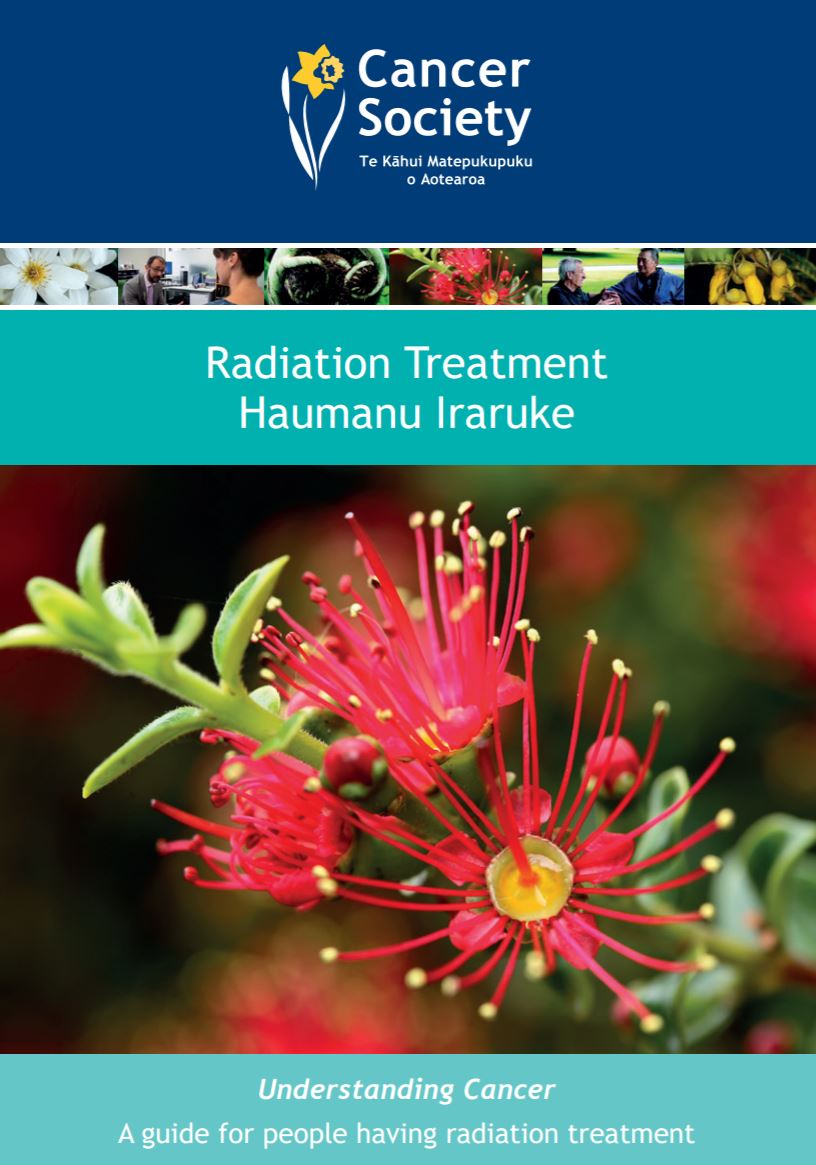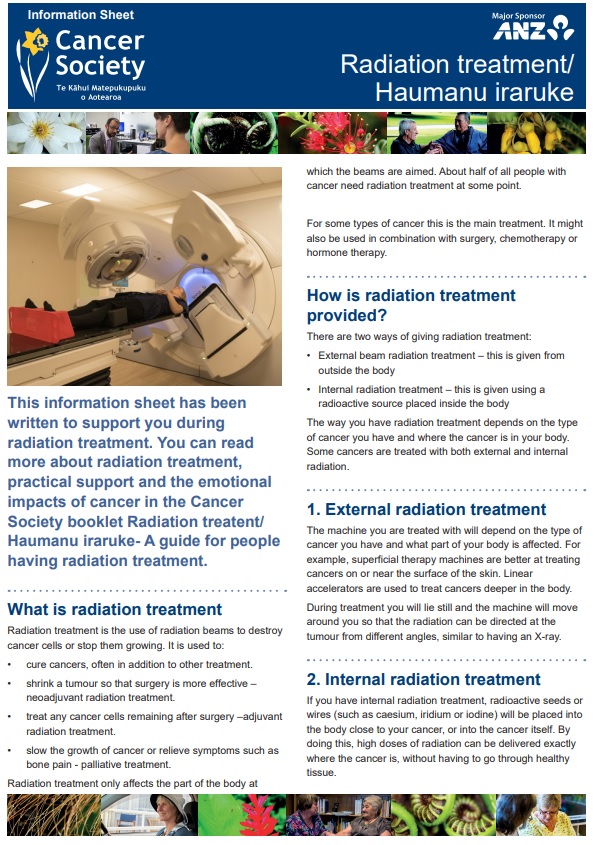Radiation treatment
Key points about radiation treatment
- Radiation treatment is sometimes called radiotherapy or radiation therapy.
- It is used to destroy cancer cells or prevent them from reproducing.
- With X-rays, low doses of radiation are used to see inside your body (eg, for a broken bone) but with radiation treatment, high doses are used at a precise point on your body to target cancer cells.
- Radiatiotherapy may be the main treatment but it might be used in combination with surgery, chemotherapy or hormone therapy.

You may already know about radiation being used at low doses for X-rays to see inside your body, eg, when you have a broken bone. In cancer therapy, radiation treatment is the use of high doses of radiation to destroy cancer cells or prevent them from reproducing. Radiation treatment only affects the part of the body at which the beam(s) is aimed, so it's very localised.
Radiation therapy works by damaging the DNA of cells. It can take days or weeks of treatment for the DNA to be damaged enough for the cells to die, then the cells keep dying for days or weeks after the radiation treatment stops.
The radiation is aimed at a precise point on your body to target cancer cells, but some healthy cells will also be damaged. After treatment, the healthy cells will repair themselves but the cancer cells will not.
About half of all people with cancer need radiation treatment at some point. For some types of cancer this is the main treatment. It might also be used in combination with surgery, chemotherapy or hormone therapy. Sometimes radiation therapy is used to treat noncancerous (benign) tumours.
Radiation treatment can be given in 2 ways – from outside the body (external radiation) or inside the body (internal radiation). External beam radiation treatment is the most common method. This is where a radiation beam is focused from a machine outside the body onto the area affected by the cancer.
With internal radiation treatment, radioactive material is put into your body, on or near the cancer. In some cases, a combination of both forms of radiation treatment is used.
In the treatment of cancer, radiation is used for different effects.
- To cure cancers, often in addition to other cancer treatment.
- To shrink a tumour, so that surgery is more effective (neoadjuvant radiation treatment).
- To treat any cancer cells remaining after surgery (adjuvant radiation treatment).
- To control cancers by slowing their growth.
- To relieve symptoms (palliative treatment), eg, to reduce pain or a cough.
What happens during treatment depends if you are having external or internal radiation treatment. You can read about radiation treatment side effects here.
A course of external radiation treatment is given over several days or weeks. Each treatment is known as a ‘fraction’. Fractions may be given every day from Monday to Friday or only 3 days a week. The rest days between treatments give your normal cells a chance to recover.
External radiation delivers a beam of radiation using a treatment machine called a linear accelerator. The exact machine used for you depends on the type of cancer you have and where in your body it is.
While you lie still, the machines are moved up and down and around you so that the radiation can be directed at the tumour from different angles. It's similar to having an X-ray taken. During this treatment you don't see or feel anything.
Planning your treatment
The process of planning external beam radiation treatment is complex and might take several weeks to complete. It's a very important part of your treatment because the treatment plan will be designed just for you to give the required dose of radiation to the cancer while sparing as much normal tissue as possible. After your planning session, check with staff on how long it will be before your treatment starts.
Simulation part of planning process
Before you start a course of external radiation treatment you will require at least 1 visit to the cancer centre to work out the exact position you will lie in during your treatment (a simulation). A simulator – a machine similar to a treatment machine or a CT scanner – is used for this.
During planning, the treatment team considers many factors, including:
- what type of radiation to use
- the size and shape of the radiation field
- your position as well as machine positioning
- how much radiation is to be delivered for each treatment
- how many beams of radiation will be used.
This is all done on computers using the information from your simulation, a CT scan, and other tests you have had.
This simulation process can take 30–60 minutes and is a much longer process than each individual treatment. It's important that you lie still in the same position when you have your treatment. You might have a range of supports to help you keep still.
Once the position of the beam is worked out, your skin or the mask (if you need one to hold your head still) will be marked. This may require a tattoo which is a permanent marking, but occasionally can be removed later. It can be helpful to have whānau or a friend with you during simulation and planning.
How long is a course of treatment?
External radiation is usually given in a number of treatments (or fractions). The number of treatments isn't necessarily related to the seriousness of the cancer. It depends on several factors, including your general health, and the site and type of cancer being treated. You might want to allow time before and after treatment each day, as delays in your appointment might occur.
If a high dose of radiation is required, it's usually given on 4 or 5 days a week for 5 to 7 weeks. If a quick response is required (eg, to relieve a cough or pain, stop bleeding or reduce swelling) a shorter course is more likely to be given. The total amount of time spent in the treatment room is usually 10–20 minutes. The machine is only turned on after the therapists have made sure you're in the correct position.
The actual treatment usually takes a very short time – a few minutes at most. Radiation treatment is available in Auckland, Hamilton, Tauranga, Palmerston North, Wellington, Christchurch and Dunedin. External radiation is usually given to you as an out-patient. If you're already in hospital, you'll be taken to the radiation treatment department each time.
Will external radiation make me radioactive?
No. External radiation treatment doesn't make you radioactive. It is safe to be with your children, family and friends both throughout the treatment and after the treatment has been completed.
Internal radiation involves placing an implant of radioactive seeds or wires into your body, close to the cancer or into the cancer itself. In this way high doses of radiation can be given exactly where the cancer is, without having to go through healthy tissue.
Two types of internal radiation therapy are:
- brachytherapy (the radioactive material is placed inside your body close to or inside the cancer)
- radioisotope therapy (a radioactive liquid is injected or swallowed).
Brachytherapy
Depending on the type of cancer and where it is in the body, brachytherapy may be temporary or permanent.
Temporary brachytherapy
Temporary (high dose rate) brachytherapy can be used in cancers such as:
- prostate cancer
- skin cancer
- cervical cancer
- endometrial cancer
- cancer of the oesophagus and bronchus
- eye cancers.
An applicator (hollow metal or plastic tube) is placed in your body, in or near the cancer, and then a very small amount of radioactive material is put inside it. A small operation might be needed to place the applicator. Depending on your treatment plan, the radiation source might be left in in for up to 1 week or just for 10–20 minutes at a time once or twice a day. Each time you go for treatment you will usually spend less than an hour in the treatment room.
Permanent brachytherapy
Permanent (low dose rate) brachytherapy can be used for some types of localised cancer, like prostate cancer. A very small (smaller than a grain of rice) piece of radioactive material is placed in or near the cancer and left in your body for the rest of your life. For the first 2 months after this you shouldn't stay very close to children/tamariki or women who are (or might be) pregnant/hapū for long periods of time. The radiation is gradually released over the next few weeks until almost all of it is gone.
Radioisotope therapy
Radioisotopes are given as liquids, in capsules (that are swallowed), as a drink or by injection into a vein (as an intravenous injection). The most common type of radioisotope treatment is radioactive iodine. It's used to treat tumours of the thyroid gland, and is given as capsules. The same safety precautions are taken with this type of treatment as for other types of internal radiation treatment.
You might need to take some special precautions for a short time after going home – and might need to avoid young children/tamariki and pregnant/hapū women for a short time. The hospital staff will explain this to you.
Radioisotope treatment can also be given if certain types of cancer have spread to your bones (secondary cancer in the bone). A radioisotope is injected into a vein and is taken up into the bone so that the radioactivity works against the cancer cells. The aim of this treatment is to reduce pain and slow the growth of cancer in the bone. This is usually given as an outpatient procedure. Secondary bone cancer is often treated with a short course of external radiation.
Before you go home you'll be given some simple advice to follow, as your urine and blood will be slightly radioactive for a few days. You might feel tired for a few weeks and you'll have regular blood tests as you might become anaemic.
Video: Targeting Cancer- Julie's Story- Diagnosis and Treatment
This video may take a few moments to load.
(RANZCR – Royal Australian and New Zealand College of Radiologists, 2015)
Video: Targeting cancer – Michael's story
This video may take a few moments to load.
(RANZCR – Royal Australian and New Zealand College of Radiologists, 2015)
Video: Targeting cancer – Evrim's story
This video may take a few moments to load.
(RANZCR – Royal Australian and New Zealand College of Radiologists, 2015)
Video: Targeting cancer - John's story
This video may take a few moments to load.
(RANZCR – Royal Australian and New Zealand College of Radiologists, 2015)
Targeting cancer – Wayne's story
This video may take a few moments to load.
(RANZCR – Royal Australian and New Zealand College of Radiologists, 2015)
Support we offer(external link) Cancer Society, NZ
NZ cancer services – find a hospital/service near you(external link) Healthpoint, NZ
More cancer support groups
Radiation treatment(external link) Cancer Society, NZ, 2018
Living well with cancer – eating well [PDF, 5.5 MB] Cancer Society, NZ, 2020. Available in the following languages: English/te reo Māori [PDF, 5.5 MB]
Supporting someone with cancer [PDF, 3 MB] Cancer Society, NZ, 2015
Emotions and cancer(external link) Cancer Society, NZ, 2020
Radiation treatment information sheet(external link) Cancer Society, NZ, 2018 Available in the following languages: English(external link), te reo Māori(external link), Chinese (simplified) [PDF, 1.4 MB], Chinese (traditional)(external link), Samoan(external link), Tongan(external link)
References
- Radiation therapy for cancer(external link) National Cancer Institute, US, 2019
- Radiation therapy(external link) Mayo Clinic, US
- External beam radiation therapy for cancer(external link) National Cancer Institute, US, 2018
- Radiation treatment(external link) Cancer Society, NZ
- Brachytherapy(external link) National Cancer Institute, US
- Radioactive strontium therapy(external link) Cancer Research UK, 2020
Continuing medical education
GP education about radiation therapy
1. Video: Targeting Cancer-Introduction to GP education evenings
This video may take a few moments to load.
(RANZCR, 2016)
2. Video: Targeting Cancer- GP Education Case Study 1 Bone Pain
This video may take a few moments to load.
(RANZCR, 2016)
3. Video: Targeting Cancer- GP Education Case Study 2 Prostate Cancer
This video may take a few moments to load.
(RANZCR, 2016)
Video: Radiation oncology webinar
This video may take a few moments to load.
(Mobile Health, NZ, 2021)
Brochures

Cancer Society, NZ, 2018

Cancer Society, NZ, 2015

Cancer Society, NZ, 2018 English, te reo Māori, Chinese (simplified), Chinese (traditional), Samoan, Tongan
Credits: Healthify editorial team. Healthify is brought to you by Health Navigator Charitable Trust.
Reviewed by: Claire Salter, Pharmacist, Tauranga
Last reviewed:
Page last updated:





